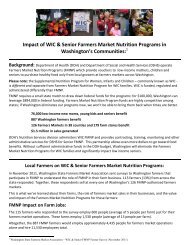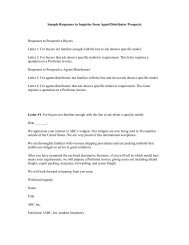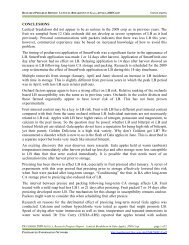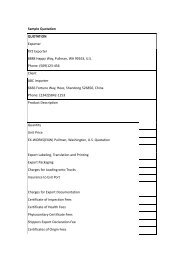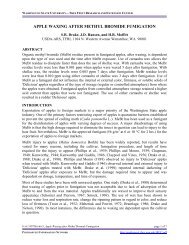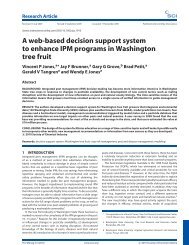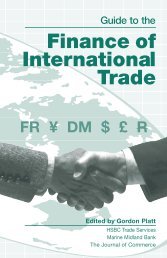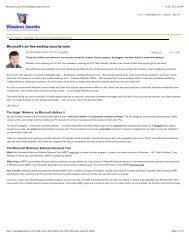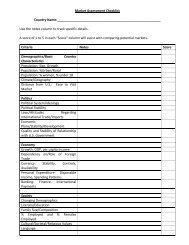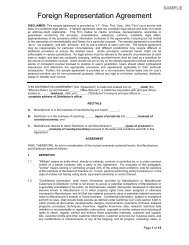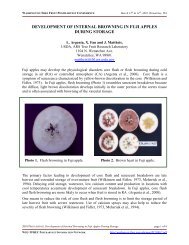Decay Control with New Tools - Postharvest Information Network
Decay Control with New Tools - Postharvest Information Network
Decay Control with New Tools - Postharvest Information Network
Create successful ePaper yourself
Turn your PDF publications into a flip-book with our unique Google optimized e-Paper software.
WASHINGTON TREE FRUIT POSTHARVEST CONFERENCEDecember 8 th , 2004, Yakima, WADECAY CONTROL WITH NEW TOOLSChang-Lin Xiao and Yong-Ki Kim, Washington State University,Tree Fruit Research and Extension Center, Wenatchee, WA 98801;Dana Faubion, WSU Extension, Yakima, WA 98902.E-mail: clxiao@wsu.eduThis presentation focuses primarily on recent developments in new technologies that haveimpacts on decay control. These technologies include 1-methylcyclopropene (1-MCP) and newpre- and postharvest fungicides. With the increasing use of 1-MCP in the apple industry,depending on varieties, many apples do not have to be drenched <strong>with</strong> diphenylamine (DPA) priorto storage. Because use of 1-MCP has been changing the traditional way the industry used tohandle apples, non-drench-based measures for decay control are needed for the MCP-based fruithandling system. In 2004, two new postharvest fungicides, Penbotec (pyrimethanil) and Scholar(fludioxonil), were registered for use on pome fruits. Some preharvest fungicides that have thepotential to control postharvest diseases are becoming available. This presentation is organizedas three parts: first, the major postharvest diseases we are dealing <strong>with</strong>; second, strategies fordecay control; and third, updates on the use of pre- and postharvest fungicides for decay control.KNOWING THE PROBLEMGray mold, blue mold, Sphaeropsis rot and Bull’s eye rot are common postharvest diseases onapples, and the first three are the major postharvest diseases on apples in Washington State(Table 1), based on the survey of postharvest diseases of apple we conducted in 2003 and 2004.In 2004 we sampled 72 grower lots including Red Delicious, Fuji and Golden Delicious. Graymold, blue mold, Sphaeropsis rot and Bull’s eye rot accounted for 23%, 44%, 18% and 4% of thetotal decay on thiabendazole (TBZ) drenched fruit, respectively, and 35%, 25%, 20% and 14% ofthe total decay on non-drenched fruit, respectively (Figure 1). On TBZ-drenched fruit, blue moldwas dominant, whereas gray mold dominated on non-drenched fruit. Sphaeropsis rot, caused bySphaeropsis pyriputrescens, is a newly reported postharvest disease of apple and pear. Thisdisease is an important component of storage rots of apple. We have seen instances of significanteconomic losses of Red Delicious and Fuji caused by Sphaeropsis rot. In the 2004 survey, Bull’seye rot was more commonly seen on Golden Delicious. It appears that a postharvest drench <strong>with</strong>Mertect TBZ reduced Bull’s eye rot.Table 1. Major target postharvest pathogens on apple and pear.ApplePearGray moldGray mold(Botrytis cinerea)(Botrytis cinerea)Blue moldBlue mold(Penicillium spp., mainly P. expansum) (Penicillium spp., mainly P. expansum)Sphaeropsis rotPhacidiopycnis rot(Sphaeropsis pyriputrescens)(Phacidiopycnis piri)Bull’s eye rot(Neofabraea spp.)Bull’s eye rot(Neofabraea spp.)2004 PROCEEDINGS, <strong>Decay</strong> <strong>Control</strong> <strong>with</strong> <strong>New</strong> <strong>Tools</strong> page 1 of 7WSU—TFREC POSTHARVEST INFORMATION NETWORKhttp://postharvest.tfrec.wsu.edu/PC2004C.pdf
WASHINGTON TREE FRUIT POSTHARVEST CONFERENCEDecember 8 th , 2004, Yakima, WA50% in the total decay40302010TBZ-drenchedNon-drenched0Gray mold Blue mold Sphaeropsis rot Bull's eyeFigure 1. Occurrence of common postharvest diseases on apple in 2004. A total of 78 growerlots either drenched <strong>with</strong> TBZ or not drenched were sampled from late March to early August.In Washington State, d’Anjou pears are usually packed shortly after harvest and stored incardboard boxes. <strong>Decay</strong> on packed fruits in the boxes is a major concern. There also are threemajor postharvest diseases on d’Anjou pears in the region (Table 1). In addition to gray moldand blue mold, Phacidiopycnis rot caused by Potebniamyces pyri (anamorph Phacidiopycnispiri) is an important component of storage rots of d’Anjou pears.Based on their origins, the common postharvest diseases of pome fruits can be divided into twocategories (Figure 2). Diseases in the first category originate from fungal latent infection of fruitin the orchard, whereas those in the second category originate primarily from infection ofwounds that occur at harvest and during postharvest handling processes. Sphaeropsis rot,Phacidiopycnis rot and Bull’s eye rot belong to the former category, and they are orchard-relatedpostharvest diseases. In the past, little research has been done to address such a group ofpostharvest diseases. In order to reduce overall losses due to postharvest diseases, decay controlshould target all major postharvest diseases in both categories.STRATEGIES FOR DECAY CONTROLThe production of apple and pear is a complex process involving orchard, storage and marketingphases. <strong>Control</strong> of postharvest diseases should involve all phases of fruit production, starting inthe orchard and completing when fruit is consumed. <strong>Decay</strong> control is not the responsibility offruit packers alone. Growers and packers need to work together to implement relevant, effectivemeasures to reduce losses due to decay. <strong>Decay</strong> control should be implemented in the context of aholistic approach, which considers the production from orchard to storage a whole system andintegrates pre- and postharvest practices to reduce overall losses due to postharvest diseases(Figure 3). As illustrated in Figure 3, there are several things that growers can do in the orchardand packers can do in the packing facility. In today’s session of this meeting, Dr. Peter Sholbergwill talk about bin and storage room sanitation (http://postharvest.tfrec.wsu.edu/PC2004F.pdf)and Dr. Doug Kelly will talk about chlorine and ORP technology(http://postharvest.tfrec.wsu.edu/PC2004B.pdf). I will give updates on the use of pre- andpostharvest fungicides for decay control.2004 PROCEEDINGS, <strong>Decay</strong> <strong>Control</strong> <strong>with</strong> <strong>New</strong> <strong>Tools</strong> page 2 of 7WSU—TFREC POSTHARVEST INFORMATION NETWORKhttp://postharvest.tfrec.wsu.edu/PC2004C.pdf
WASHINGTON TREE FRUIT POSTHARVEST CONFERENCEDecember 8 th , 2004, Yakima, WAFigure 2. Origin of postharvest diseases of pome fruits. Diseases in category 1 are orchardrelatedpostharvest diseases. Diseases in the category 2 essentially originate from infection ofwounds, though calyx-end gray mold may also originate from infection of calyx tissues beforeharvest.Figure 3. Illustration of a holistic approach to decay control (note: registrations of Elevateand Pristine are still pending at the time of writing this publication).USE OF PRE- AND POSTHARVEST FUNGICIDESThiabendazole (TBZ, Mertect) has been the only postharvest fungicide commonly used as eitherdrench treatments or online sprays in pome fruits since it was introduced in 1968. A postharvestdrench <strong>with</strong> TBZ has been a common practice to treat apples before they are put into the storageroom. Thiabendazole is still effective to control gray mold, but resistance to TBZ in Penicilliumexpansum populations has been a problem on drenched fruit. In 2004, two new postharvestfungicides, Penbotec (pyrimethanil) from Janssen Pharmaceutica and Scholar (fludioxonil) from2004 PROCEEDINGS, <strong>Decay</strong> <strong>Control</strong> <strong>with</strong> <strong>New</strong> <strong>Tools</strong> page 3 of 7WSU—TFREC POSTHARVEST INFORMATION NETWORKhttp://postharvest.tfrec.wsu.edu/PC2004C.pdf
WASHINGTON TREE FRUIT POSTHARVEST CONFERENCEDecember 8 th , 2004, Yakima, WASyngenta, were registered for use on pome fruits. Today we have representatives from bothcompanies at the meeting, and they will give updates on these two products. I will provideupdates on preharvest fungicides.Use of preharvest fungicides is needed to reduce amount of decay, particularly on long-termstored fruits in field bins that have not been treated <strong>with</strong> postharvest fungicides prior to storage.The benefits from preharvest fungicide applications are (1) to reduce or control latent infections,(2) to reduce spore load on the surfaces of the fruit, and (3) to protect wounds that occur atharvest and during the handling process from infection by decay-causing pathogens. <strong>Control</strong> ofblue mold and gray mold originating from infection of wounds is particularly important. Broadspectrumfungicides such as thiram and ziram are effective to reduce spore inoculum on fruitsurfaces, but their residual activity to protect wounds that occur at harvest from infection bydecay-causing pathogens is limited compared <strong>with</strong> some newer fungicides we have tested. Athorough coverage achieved through a high-volume ground application is essential to the successof a preharvest application of fungicides for decay control.I will particularly mention two new fungicides, Elevate (fenhexamid) and Pristine(pyraclostrobin plus boscalid). Registration of Elevate for use on pome fruits is still pending.The proposed label of Elevate includes use as a either preharvest treatment or postharvesttreatment. Because Elevate is not effective to control Penicillium expansum, I do not recommendit as a postharvest treatment. Our field studies indicated that Elevate applied shortly beforeharvest was effective to control gray mold originating from wound infections. It appears that thecloser to harvest the fungicide was applied, the better the control it provided (Figure 4).Incidence of gray mold (%)12010080604020ababaab0No fungicideElevate@ 1 dayElevate@ 2 wkThiram @ 2 wkZiram@2 wkFigure 4. Effects of preharvest fungicides on gray mold on Gala apples. Elevate was appliedat either 1 day or 2 weeks before harvest, and thiram and ziram were applied at 2 weeksbefore harvest. Fruit were wounded and inoculated shortly after harvest <strong>with</strong> sporesuspensions of Botrytis cinerea. Fruit were then stored in air at 32 ºF for 10 weeks.2004 PROCEEDINGS, <strong>Decay</strong> <strong>Control</strong> <strong>with</strong> <strong>New</strong> <strong>Tools</strong> page 4 of 7WSU—TFREC POSTHARVEST INFORMATION NETWORKhttp://postharvest.tfrec.wsu.edu/PC2004C.pdf
WASHINGTON TREE FRUIT POSTHARVEST CONFERENCEDecember 8 th , 2004, Yakima, WACaptevate is a premixed formulation of Captan and Elevate. It appears that Captevate provided abetter control of gray mold than Elevate alone (Figure 5). Captevate is not yet registered for useon apples.10080Gray mold% fruit rot604020010080<strong>Control</strong> Elevate Captevate Pristine ThiramBlue mold% fruit rot6040200<strong>Control</strong> Elevate Captevate Pristine ThiramFigure 5. Preharvest applications of fungicides for control of gray mold and blue moldoriginating from wound infections. Fungicides were applied at 7 days before harvest. Fruitwere wounded and inoculated <strong>with</strong> conidial suspensions of either B. cinerea or P. expansum.Fruit were stored in air at 32 ºF for two months, at which time decay was assessed.Pristine is a new fungicide that has two active ingredients belonging to two different classes offungicides. It has been labeled for use on sweet cherry. Registration for use on pome fruits isexpected in 2005. Pristine applied at 7 days before harvest was effective to control both graymold and blue mold originating from infection of wounds (Figure 5).In collaboration <strong>with</strong> a packer in Yakima, we conducted a trial in a commercial Fuji orchard toevaluate pre- and postharvest fungicide treatments for decay control (Figures 6 and 7). The decaylevel after 6 months of storage was not high in that particular year. Fruit treated only <strong>with</strong>preharvest Flint has a significantly lower percent decay compared <strong>with</strong> other treatments, but fruitfrom the three treatments consisting of postharvest drench <strong>with</strong> Mertect TBZ and DPA had2004 PROCEEDINGS, <strong>Decay</strong> <strong>Control</strong> <strong>with</strong> <strong>New</strong> <strong>Tools</strong> page 5 of 7WSU—TFREC POSTHARVEST INFORMATION NETWORKhttp://postharvest.tfrec.wsu.edu/PC2004C.pdf
WASHINGTON TREE FRUIT POSTHARVEST CONFERENCEDecember 8 th , 2004, Yakima, WAhigher percentages of decay as compared <strong>with</strong> the three non-drench treatments (Figure 6). This islikely due to the resistance of Penicillium expansum to TBZ. Blue mold dominated on drenchedfruit, whereas gray mold dominated on non-drenched fruit (Figure 7).4a% decay in storage bins321bbccd0Ziram+DPA+M DPA+M Flint+DPA+M <strong>Control</strong> Ziram FlintTreatmentsFigure 6. <strong>Control</strong> of postharvest decay on Fuji apples <strong>with</strong> pre- and postharvest fungicides ina trial conducted in a commercial orchard. Flint and ziram were applied at 14 days beforeharvest. After harvest, part of fungicide-treated fruit and non-treated fruit was drenched <strong>with</strong>DPA plus Mertect TBZ (M). Fruit were treated <strong>with</strong> 1-MCP and stored in RA for six months,at which time decay was assessed.% gray mold and blue mold in the total decay100806040200AeBGray moldBlue molddBc<strong>Control</strong> Ziram Flint Flint+DPA+M DPA+M Ziram+DPA+MCbCaCabTreatmentsFigure 7. <strong>Control</strong> of postharvest decay on Fuji apples <strong>with</strong> pre- and postharvest fungicides ina trial conducted in a commercial orchard. Flint and ziram were applied at 14 days beforeharvest. After harvest, part of fungicide-treated fruit and non-treated fruit was drenched <strong>with</strong>DPA plus Mertect TBZ (M). Fruit were treated <strong>with</strong> 1-MCP and stored in RA for six months,at which time decay was assessed. Percentages of gray mold and blue mold in the total decayin each treatment were determined.2004 PROCEEDINGS, <strong>Decay</strong> <strong>Control</strong> <strong>with</strong> <strong>New</strong> <strong>Tools</strong> page 6 of 7WSU—TFREC POSTHARVEST INFORMATION NETWORKhttp://postharvest.tfrec.wsu.edu/PC2004C.pdf
WASHINGTON TREE FRUIT POSTHARVEST CONFERENCEDecember 8 th , 2004, Yakima, WAIn summary, we have two new postharvest fungicides available now. <strong>New</strong> preharvest fungicidesare likely becoming available. We have more tools in the tool box for decay control. But again,decay-control measures should be implemented in the context of a holistic approach as illustratedin Figure 3. Grower and packers should work together and implement orchard-specific programsfor decay control.ACKNOWLEDGMENTSWe thank Robin Boal for technical assistance; various packinghouses for assistance <strong>with</strong>sampling; and the Washington Tree Fruit Research Commission and Washington StateCommission on Pesticide Registration for financial support.2004 PROCEEDINGS, <strong>Decay</strong> <strong>Control</strong> <strong>with</strong> <strong>New</strong> <strong>Tools</strong> page 7 of 7WSU—TFREC POSTHARVEST INFORMATION NETWORKhttp://postharvest.tfrec.wsu.edu/PC2004C.pdf




